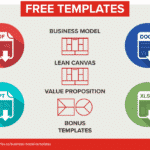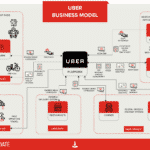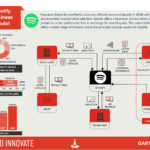Apple is probably one of the most iconic brands of our time. The Apple business model is an ecosystem of products, services and apps that seamlessly integrate. But is the Apple business model sustainable?
The Apple business model is changing and evolving. In this article, I’ll show you how Apple makes money, what underpins the success of its business model and what we can expect to see in the future.
Table of Contents
Key Facts About Apple
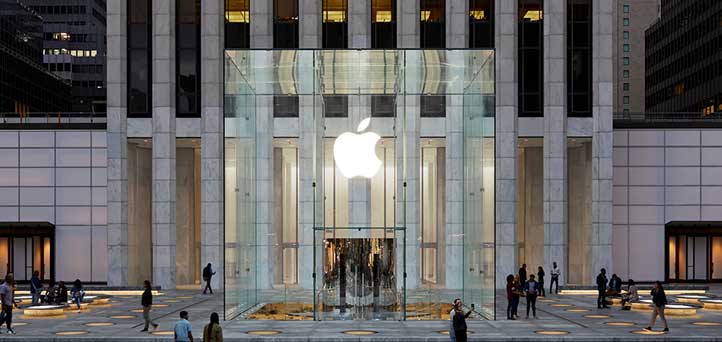
| Company name: | Apple |
| Founders: | Steve Jobs, Steve Wozniak, and Ronald Wayne |
| Annual revenue: | (FY 2019): $260.17 Billion |
| Profit | Net Income: | FY 2019: $ 55.25 Billion |
| Market Cap: | (Feb, 2020): $1.19 Trillion |
| Year founded: | 1976 |
| Company CEO: | Tim Cook |
| Headquarters: | Cupertino, California, USA |
| Link: | Apple |
| Number of employees: | (FY 2019): 137,000 |
| Type of business: | Public |
| Ticker symbol: | AAPL |
| Products And Services: | Mac, Macbook, iPad, iPhone, Apple Watch, TV+, Apple Music, Apple Arcade (Gaming Platform), App Store, iCloud |
Some Frequently Questions About Apple’s Business Model
What Is The Apple Business Model?
Apple produces premium consumer electronic products that are known for their design and ease of use. The business model is based on combining software, products and apps to form a complete ecosystem of solutions for customers.
Which type of e-business model best describes apple?
Apple sells directly to customers as well as through other etail and retail partners many of whom act as service centres. Their partner network is a key resource for the Apple business model.
What is the Apple Pay business model?
Apple makes money from Apple pay by taking a cut of the transactions fees charged to the card-issuing bank. So, in simple terms, they make money by facilitating the transaction.
How much revenue does apple make a year?
In 2019, Apple generated $260.17 billion dollars in revenue. iPhone sales accounted for 55% of total sales, followed by Services (46 Bn) 18%, Mac ($25.74 Bn) 10%, Wearables/home/accessories ($24 bn) 9% and iPad ($21 Bn) 8%.
Where does Apple make most of its revenue?
The majority of Apple’s revenue comes from products (82%) and services (18%). However, Apple’s services which include Apple store, music streaming and TV+, creates a significantly larger gross margin of 63.70% compared to $32.20 for products.
How many people use Apple products?
Apple disclosed that it has an install base of over 900 million users for the iPhone alone. Using the sales of other products it is estimated that there are over 1.1 billion people using Apple products Globally.
How much is Apple worth?
Apple became the world’s company to hit a market capitalization of $1 Trillion and it has subsequently passed the $1.3 trillion mark in December 2019.
In this article, we’ll explore some of the incredible numbers of this global powerhouse of a brand.
The Apple Watch outsold all of the Swiss watch industry by sales volume in 2019.

To see a large scale version of this infographic on how Apple makes money from its business model – click on the button.
Apple’s Products and Services
| Products | Operating Systems | Services |
|---|---|---|
| iPhone | iOS | App store |
| Mac | MacOS | iCloud |
| iPad | watchOS | Music streaming |
| Wearables, Home, and Accessories | tvOS | TV+ |
| Arcade (Gaming) |
Apple’s Revenue and Profits in 2019
Despite Apple’s lack of growth, many investors are still excited about its future. I’ll take you through why in a review of Apple’s business model below.
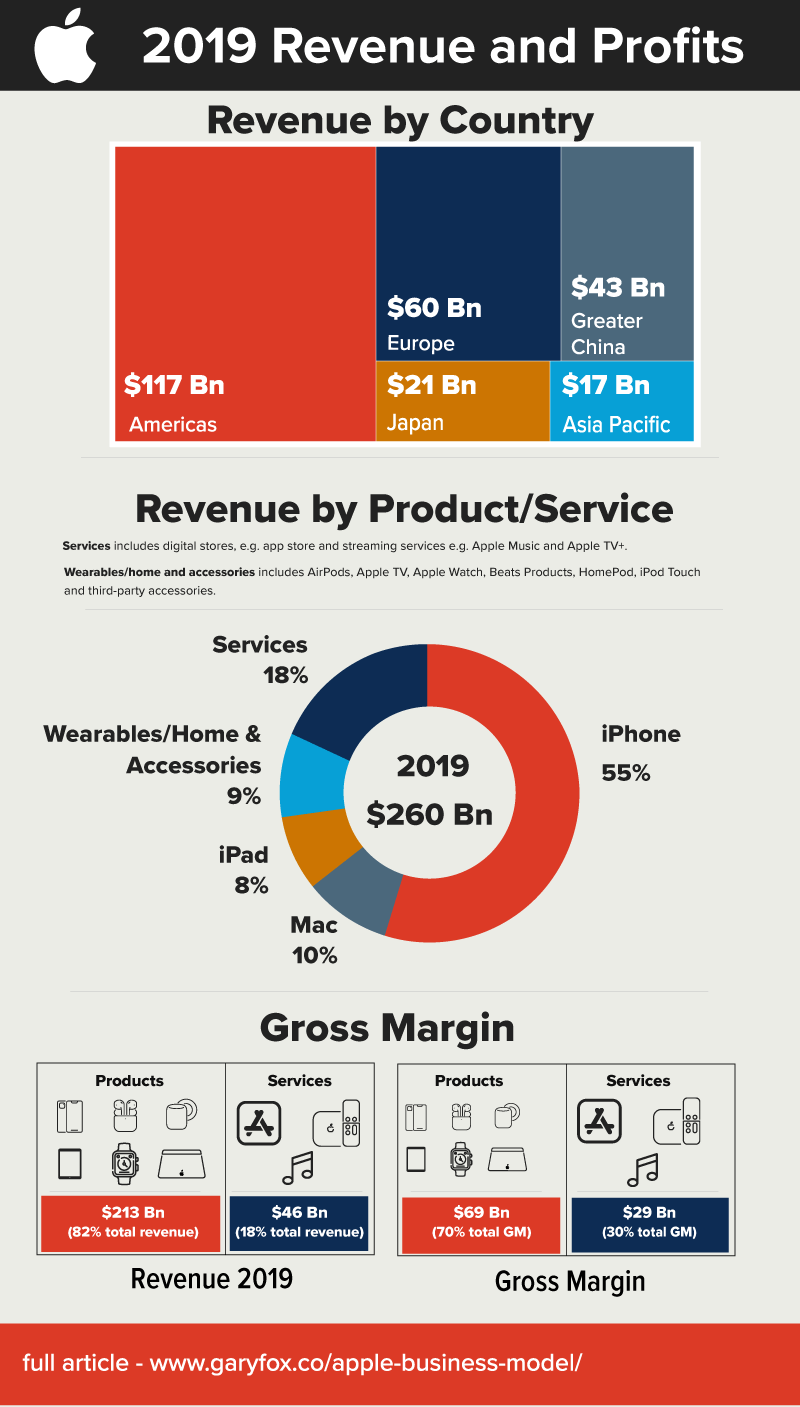
Apple’s Performance Products and Services
Many might think that a two per cent decline in revenue might be a blip in Apple’s performance. However, the Apple SWOT analysis takes a much deeper look at the problems and opportunities Apple is now facing.
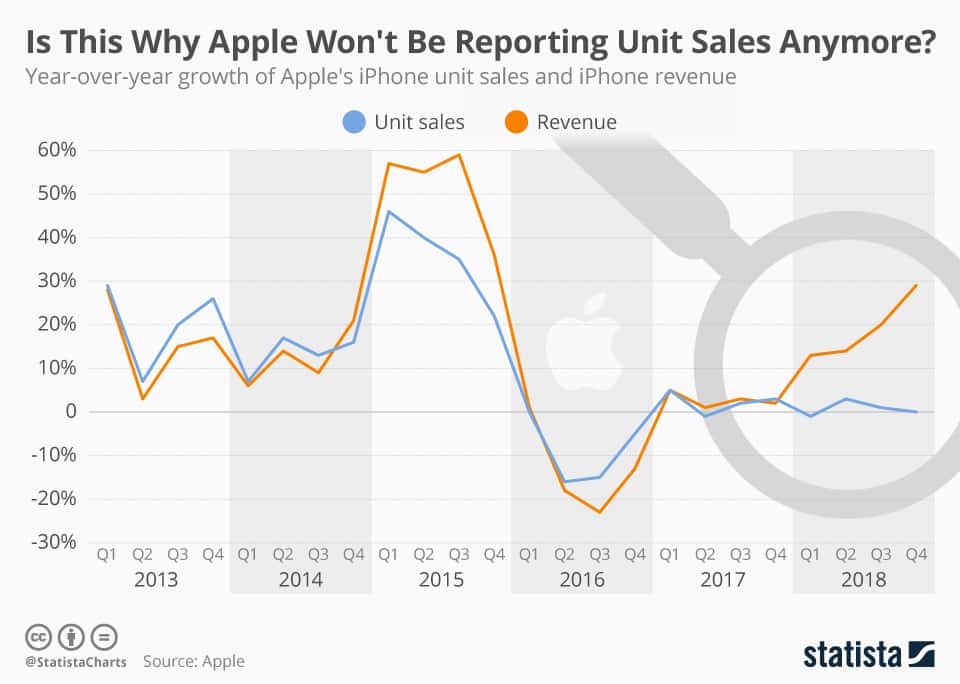
- Slow growth or declining numbers across a number of products:
- iPhone sales are declining – 14% decline 2019 vs 2018. (why important – iPhone accounts for 55% of all sales)
- Mac sales are flatlining – marginal 2% growth
- The rising stars:
- Wearables – according to analysts, the Apple Watch continues to be the market leader with approximately a 48% share of the smartwatch market.
- Services – the more profitable subscription business model that Apple is pursuing is based on layering entertainment on top of their product base – the product base becomes the distribution network for their services.
Apple’s Regional Performance

There is no question that Apple’s user growth is slowing. Much of this is due to Apple running out of premium smartphone users in key markets like China and India.
- Apple is facing fierce competition from a host of manufacturers. In particular, sales in China dropped by $8 Bn and the rest of Asia was static.
- China is the largest smartphone marketing in the world. However, Apple’s products are premium and that leaves the majority of people in China unable to afford Apple products.
- Chinese companies such as Huawei and Xiaomi, have stolen Apple’s market share. Huawei overtook the iPhone in China to become the world’s second-biggest smartphone maker, behind Samsung.
- Even in Europe Apple has lost ground to competitors who offer equivalent feature sets at much lower costs.
In countries like India and Brazil, Apple needs to have lower-priced products like iPhones. However, it is the wearable technology that may become the biggest opportunity, if Apple can deliver an accessible price point may not be the best tools to bring new users into the ecosystem.
Is The Apple Business Model Under Threat?
In a mad dash to stave off the competition Apple is bringing out lower cost, smaller iPhones…but will it be enough?
If we use disruption theory we can see that Apple is ripe for disruption.
So why is Apple’s stock price still high? Why do investors still think the Apple business model has a strong future.
What Is The Future For Apple?
Apple’s recent growth has come from the growth in its streaming services – TV+ and Music as well as the success of Apple Watch.
The much stronger margin contribution and the move from selling products (one-off transactions) to a subscription business model (streaming TV and Music) provides a more profitable and recurring revenue.
The big play though is in the healthcare market worth an estimated $3 trillion dollars.
The Apple Watch opens up new possibilities for further digital subscription models based on the collection and use of data. Turning the Big Data into personalized services fits to the future trend of healthcare and open up new revenue streams for Apple.
Apple recently acquired AI startup Voysis to boost its natural language capabilities with Siri. However, this AI capability can be applied to a much broader set of uses including AI.
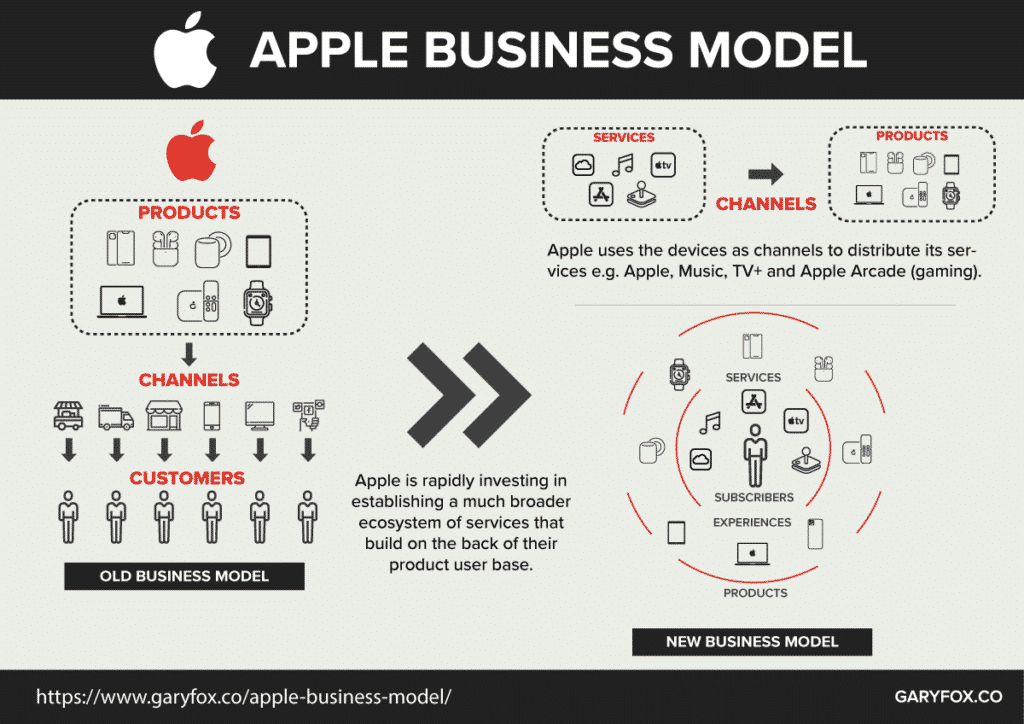
The Apple Business Model Canvas
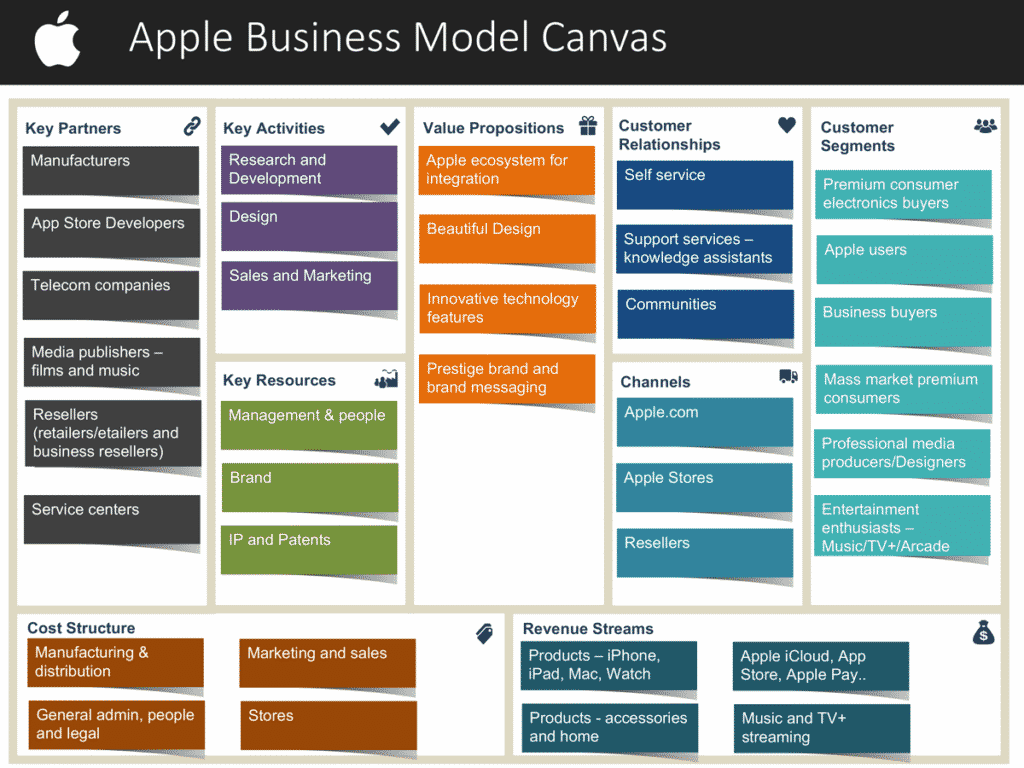
This core Apple business model relies on the integration of content (software, media, and apps) and hardware (laptops, phones, and tablets) to drive growth.
The Apple Business Model – Customer Segments
Apple has a diverse set of business models it uses e.g. a different business model is used and applied for products compared to services.
In the customer segment, you can breakdown the customer segment by products/services, demographics and psychographic. For more details on customer segmentation click the link.
Geographic Customer Segments
Apple operates globally but that doesn’t necessarily mean it has the same mix of customers in each market. In developing countries it is mainly the affluent that can afford Apple prices as a result of average wages being lower.
Demographic, Psychographic and Behavioural Segments
The highest uptake of Apple iPhones are teenagers in the US but the highest spenders are older generations. However, the complexities of breaking down segments vary by Country, age, lifestyle, income, personality, and behaviors e.g. lifestyle.
As an example, in examing single households, there are significant differences in spending based on age.
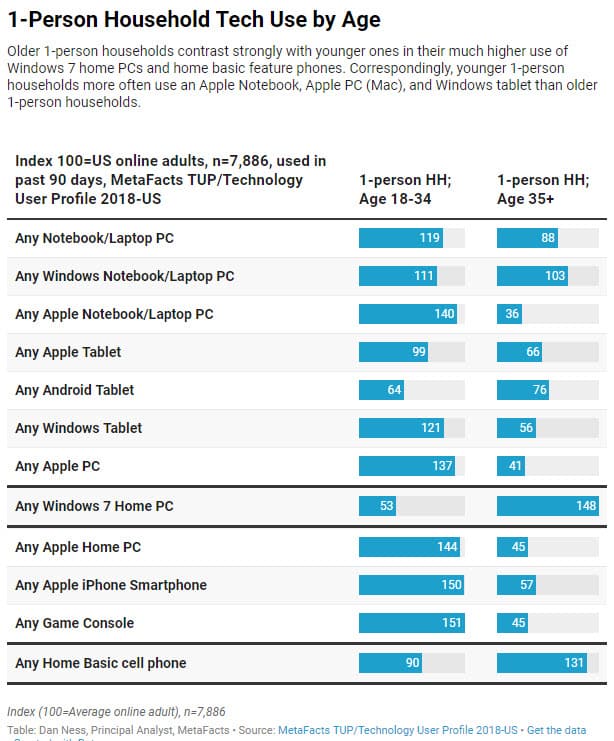
The Apple Business Model Value Propositions
The core value proposition was around the products and operating systems that formed the main revenue streams for Apple. More recently, Apple has expanded into services such as music streaming and TV+. These build on the core value propositions but also have their own distinct ones.
- Think different
- Tech that works
- Your privacy is safe with us.
Think Different
“Think different” is the invitation from Apple to be creative. Since its early days, the Mac was associated with designers and it has since used that to foster and encourage creativity through its devices.
Tech that works
The promise is simplicity, ease of use and seamless integration across devices.
Even in the early day’s Apple used to take swipes at its competitor Microsoft based on this simple value proposition.
I can easily use my iPad as a second screen with my Macbook – no configuration or settings required it’s just there as an option. That level of ease of use has led to Apple’s status as a technology built around the user.
Your privacy is safe with us.
Google’s business model is based on selling your search behavior to bidders. As an example, if you were looking for a new car, then you would see on each search page an ad for a car. Google collects your data and then refines your search based on your preferences and then uses this to optimize ad clicks.
Apple doesn’t rely on ad revenue and uses this as part of its value proposition. Furthermore, the iOS software provides options for users to use ad blockers.
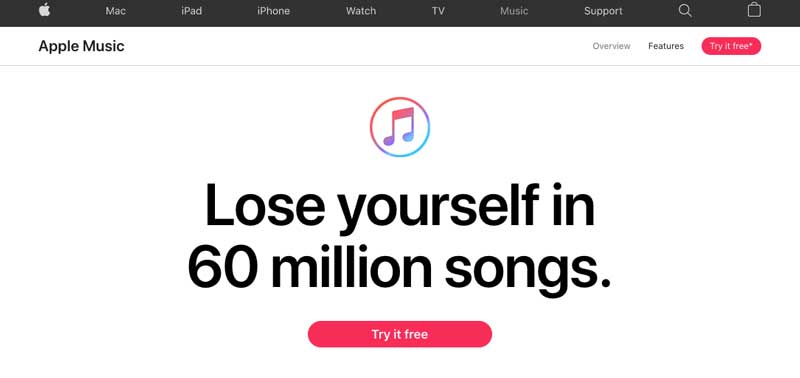
Music streaming services like Spotify and Apple Music accounted for 80 percent of all recorded music revenue in 2019 in the US and close to 50% globally. The value proposition for music streaming relies on on-demand service, breadth of music and quality. Apple’s ecosystem of devices is perfectly placed to help integrate and sell its music offer.
Apple Arcade
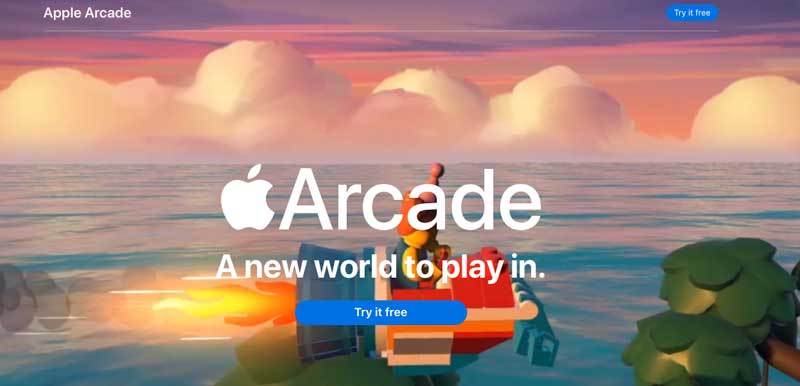
Apple’s Distribution Channels
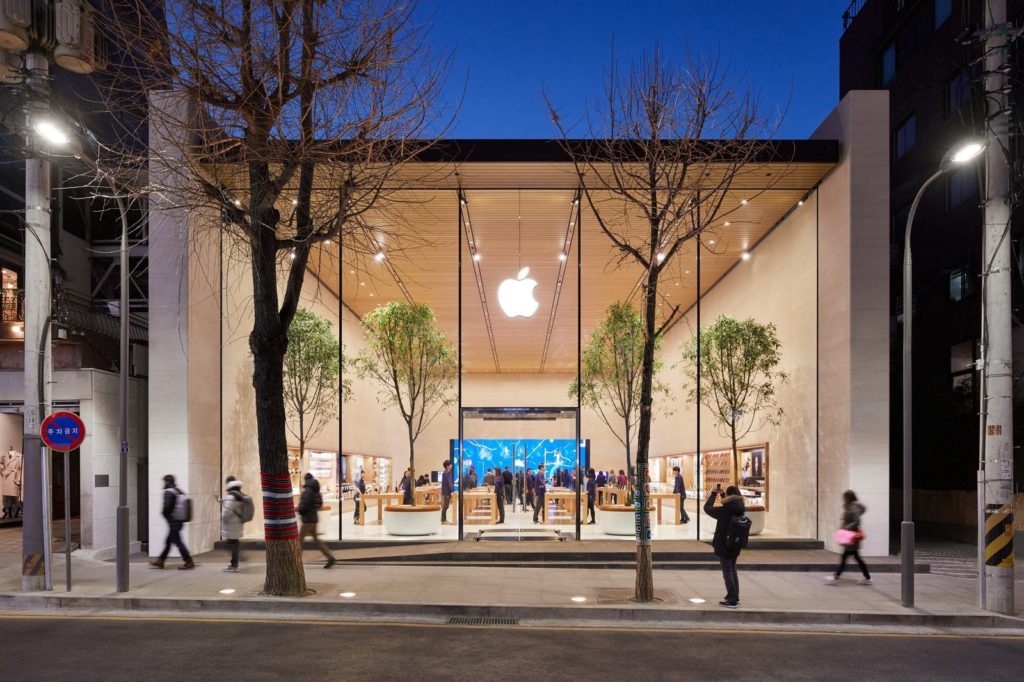
In a business model, the channels segment doesn’t just refer to distribution.
How you reach and communicate is equally important.
You marketing channels are the mechanisms for how you create brand awareness, develop customer relationships, offer customer service as well as acquire customers.
Apple’s Distribution Channels
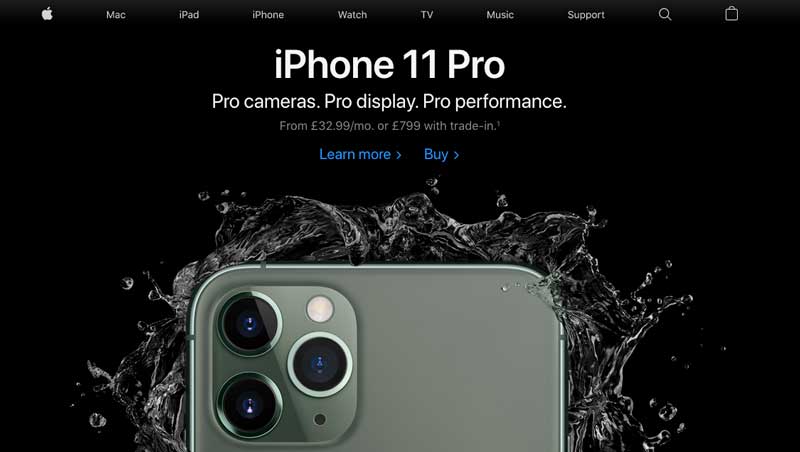
- Apple Stores.
- Apple’s websites.
- Third-Party Stores (Many of these also act as service centers forApple).
- Resellers (resellers sell to B2B clients).
- Telecom Companies (the majority of iPhones are sold bundled with a mobile package to spread costs).
Apple’s Marketing Channels
Apple has over many years created a devoted fan base. From the legendary figure of Steve Jobs through to the innovative products, people talk about Apple. Add to this their famous minimalist branding and status and you have the perfect recipe for PR.
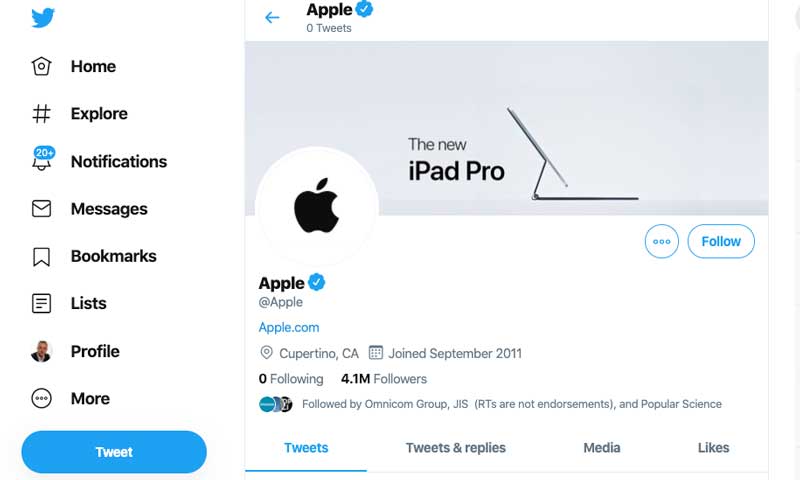
Apple’s Customer Relationships

The customer relationship block defines the type of relationship the business wants with its customers. In turn, this determines the level and type of resources that are needed to deliver the customer experience.
Apple has an install base for iPhones of over 900 million. Globally, it is estimated there are over 1.1 billion Apple users. What does that mean for how they manage relationships?
Of course, the obvious benefit of creating beautifully designed products and software is that it reduces support costs.
The relationships between the products and services are quite different. Products which are transactional relationships aim to keep costs to a minimum and operate a self-service model.
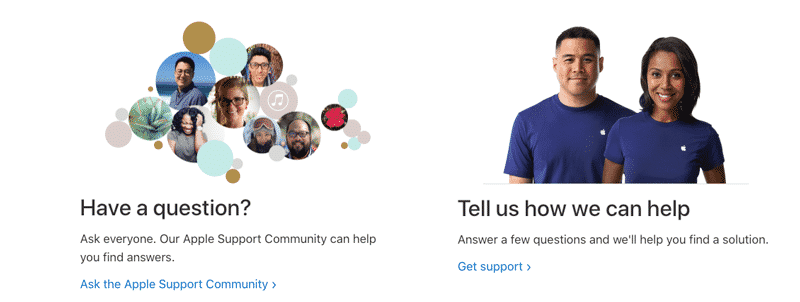
- Genius bars in Apple shops – these provide a physical place where people can explore how to use devices and software. The relative coverage is low though and this is primarily to onboard and showcase products to potential new customers.
- Customer Support – This is where Apple provides a range of self-support options. In cases of damage or repair, you are pointed to either official Apple stores or Service Centres.
- Telephone customer support
- Chat support
- Communities – With the number of Apple fans out there its no surprise that you can easily connect with them across channels such as YouTube to find help and support, lessons on software and much more.
Apple’s Key Activities
The key activities section reflects the core strategic capabilities of Apple. In simple terms, what it does best and resources.
Apple’s distinctive activities encompass innovation, marketing, quality, strong customer service, simplicity, and strong financial performance.
- Design
- Research and development
- Branding
Apple Design
Apple has been the leader in designing consumer electronics for many years. However, more recently other companies have started to focus on design. Additionally, Jony Ive left Apple to set up his own design company – on the day that was announced Apple value on the stock market dropped by $9 billion. Jony Ive’s new company has already got its first customer though – Apple!
Research and Development
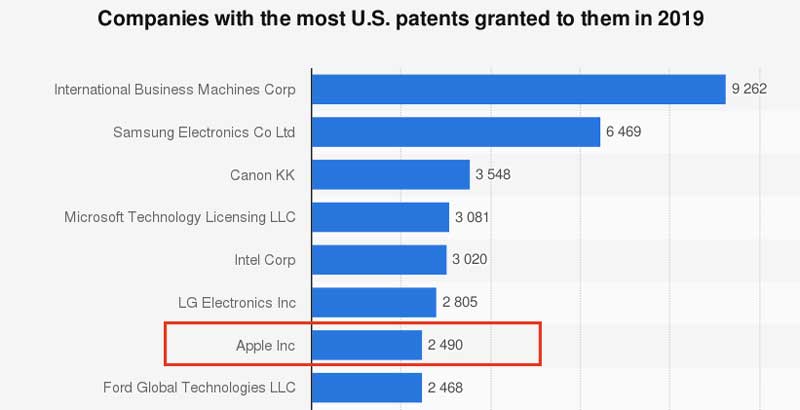
| 2019 | 2018 | 2017 | |
| Research and Development Spend ($millions) | 16,217 | 14,236 | 11,581 |
Design and innovation are two sides of the same coin.
New technologies enable new ways to design new products and services that change how you can communicate, interact with media and much more.
Apple has continually invested in research and development that pushes the boundaries and limits of technologies. To maintain its position, Apple invests in research and development but it also acquires companies to accelerate technology capabilities.
Branding

In 2019, Apple was once again valued as the most valuable brand for the 7th year in a row by Interbrand.
This trinity of capabilities R&D, design and technology provide the fuel that continues to propel Apple’s marketing into new markets.
Apple Business Model – Key Partnerships
The Apple business model key partnerships block defines the services that Apple needs to deliver its overall business.
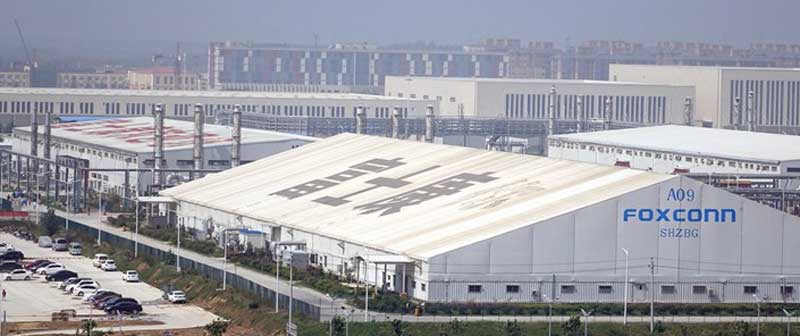
The activities that Apple doesn’t view as strategically core it outsources. In other words, Apple has a network of broad set partnerships that help it to deliver manufacture and supply the enormous number of products and services it offers.
Here is a sample of some of the many different types of business partners Apple relies on to deliver its operations and services globally:
| Type of Partner | Partner |
|---|---|
| Operations (ICT) | Cisco |
| Business (Consultancy) | Accenture |
| Qualcomm | Semi-conductors |
| Cloud Services | Amazon/Google |
| Memory | Samsung |
| Apple Watch | Texas Instruments |
| IOT | General Electric |
| AT&T | Partners who distribute and bundle Apple products with their telecom services |
Apple Business Model – Key Resources
Apple business model resources are listed below:
- The legacy of Steve Jobs – he was the fearless leader who pioneered new products, new services and made the Apple brand as recognizable as Coca-Cola.
- Brand – The power and strength of the Apple brand – worth billions in PR, word of mouth – let alone the fanatical fans that provide a powerhouse of evangelists.
- Intellectual Property and Research – the patents that secure Apple’s future and provide it with unique technologies that maintain its position in the market.
- People – Apple attracts recruits, trains and retains some of the best talent in the world across all. parts of its business.
- Management Team – the top management team of Apple continue to steer the company toward growth and profits.
Apple Business Model – Cost Structure

Apple stores are located in prime positions in the most expensive capital cities around the world. Additionally, they are known for the outstanding level of design that goes into the store. Add to this the staff, training and equipment and you have a hefty bill just for your retail division.
Costs related to business operations include:
- Manufacturing/distribution – this is the main reason why physical products have a lower margin than services.
- Selling – people, systems, and marketing
- General and administrative – departments, systems, people and operations that underpin the delivery of the business.
Apple Business Model – Revenue Streams
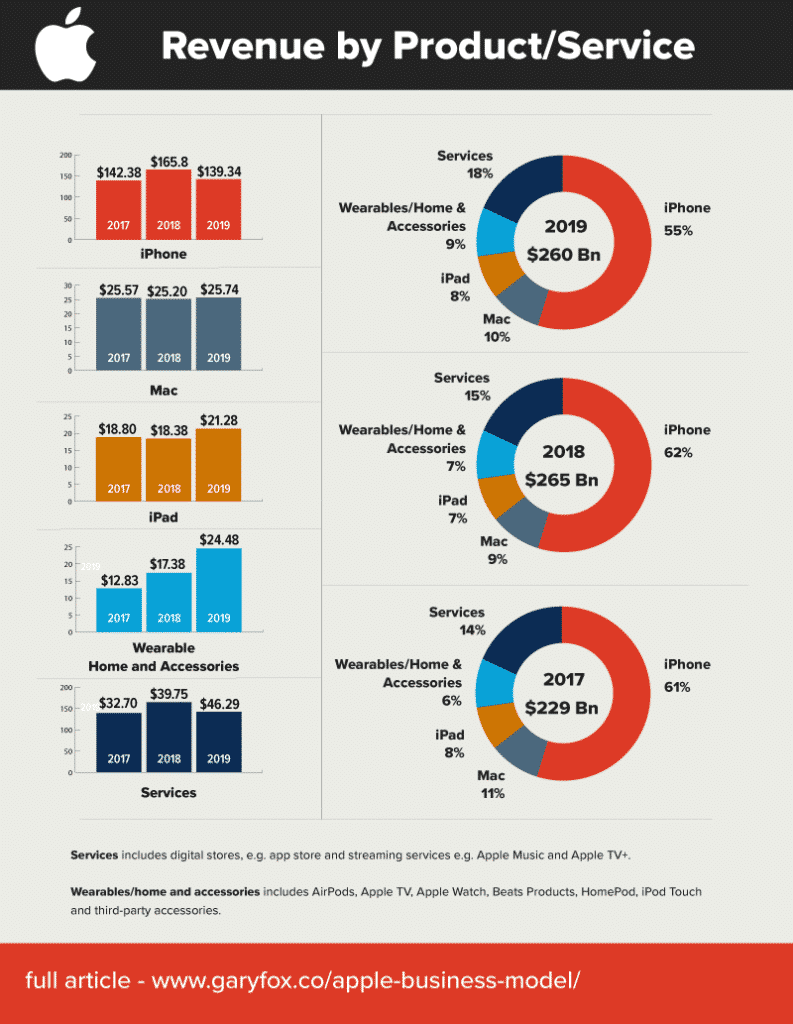
The main revenue streams have been covered earlier in this article.
What remains to be seen is if Apple can reinvigorate its growth with its next set of products.

